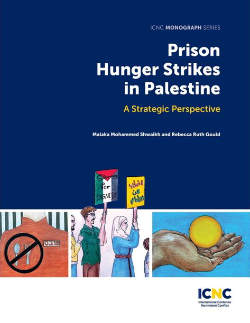by Yousef Aljamal
This following book review by Palestinian rights activist, author, and translator Yousef Aljamal is crossposted from the Washington Report on Middle East Affairs.
Prison Hunger Strikes in Palestine provides a unique window into the “culture” of hunger striking, as the two authors describe it, among Palestinian prisoners in Israeli jails.
The introduction of the book points out that starvation as a form of protest is a well-documented practice aimed to achieve justice that dates back to medieval Ireland. The authors note that when it comes to hunger strikes, the need for dignity and freedom outweighs the feelings of hunger and thirst. Malaka Mohammed Shwaikh and Rebecca Ruth Gould explain how hunger strikers watch their bodies get weaker and their organs decay, but their need for freedom makes these life-threatening changes less relevant, turning their bodies into “a formidable weapon at their disposal.”
Pulling from recent events, the story of late Palestinian hunger striker Khader Adnan is mentioned at the beginning of the book. Adnan had staged a new phase in the individual struggle of Palestinian prisoners in Israeli jails by going on six hunger strikes while serving eight years in total in Israeli jails, losing his life on May 2, 2023, after an 87-day hunger strike. Israel currently holds his body.
The book quotes Pat Sheehan, a former Irish Republican hunger striker, as saying: “We were not going on hunger strike to die. We were going on hunger strike to show the world that an injustice had been done on us.” Sheehan and Adnan published their stories in a book titled A Shared Struggle (co–authored by this reviewer). Following the death of Adnan, the Bobby Sands Trust in Ireland published a statement which read, “Khader, who was 45, had been cruelly interned by Israel 12 times under administrative detention.”
Prison Hunger Strikes in Palestine also addresses the cases of Palestinian hunger strikers Awni al-Sheikh, Etaf Elian, Mona Qa’dan, Hana Shalabi, Shireen Issawi and Samer Issawi, “who carried out the lengthiest hunger strike in the Palestinian prisoners’ movement history that lasted 277 days.” Each story is unique, including that of Shireen and Samer, two siblings who went on hunger strike in Israeli jails, which reveals the generational aspect of Israel’s prolonged military occupation of Palestine. Hana Shalabi was one of the first Palestinian women to go on an individual hunger strike to protest her administrative detention. She was eventually deported to Gaza in 2012 after 44 days of hunger strike.
Shwaikh and Gould explain the differences and motivations behind individual and mass hunger strikes by Palestinians in Israeli prisons, outlining their successes and failures. The demands of individual hunger strikes include ending administrative detention, while the demands of mass hunger strikes center on family visits, access to education, ending solitary confinement for prisoners, having access to family calls, medical treatment and better living conditions inside the prisons.
The third chapter of the book explores how hunger strikes are staged from start to finish, which includes coordination and planning across different prisons, a process that might last months and could face challenges such as a lack of unity regarding the decision to go on a mass hunger strike due to internal politics and differences among the leadership. In some cases, mass hunger strikes were called off due to the ability of the prisoners’ movement to achieve their demands through negotiations with the prison administration.
During hunger strikes, the book explains, it is crucial to have an effective communication strategy, both with the prison administration as well as with the outside world (e.g. writing letters). In some cases, hunger strikes failed because of a lack of publicity and public support, two factors that impact the Israel Prison Service’s (IPS) decision to meet the demands of hunger strikers. As “the first day is the hardest” in a hunger strike, it is important to keep the momentum and participation level, with some prisoners and prisons joining the strike later, and others excluded due to health issues or inability.
Shwaikh and Gould outline how the prison administration engages in a campaign of intimidation after prisoners go on hunger strike by using repression and threats, solitary confinement and banning communication with the outside world. The prisoners, on their part, respond to the IPS’ repression—which does not stop with the end of hunger strikes—by showing patience and persistence, by “sticking rigorously to the strike.”
Prison Hunger Strikes in Palestine concludes by stating that the success and failure of hunger strikes is measured by a number of factors, giving the example of the favorable international environment in the case of mass hunger strikes in South Africa and Ireland, which Palestinians do not enjoy. The authors conclude that having their demands met is not the only factor to determine the success of hunger strikes, as the prison administration might reverse its concessions, noting that long-term achievements such as global solidarity should also be considered.
Shwaikh and Gould’s book provides in-depth knowledge as to why and how Palestinian prisoners go on a hunger strike, both individually and en masse, while drawing on other examples from British India, South Africa, Ireland and elsewhere. It is one of few manuscripts that outlines the experiences of Palestinian hunger strikers by having direct interviews with them, linking their experiences to Ireland in particular. This is not new, as Palestinian prisoners sent a letter out of Nafha Prison in solidarity with Republican Irish hunger strikers in 1981, including the late Bobby Sands, who said: “Our revenge will be the laughter of our children.”
Will Palestinian prisoners have the same joy one day? Only time will tell.

